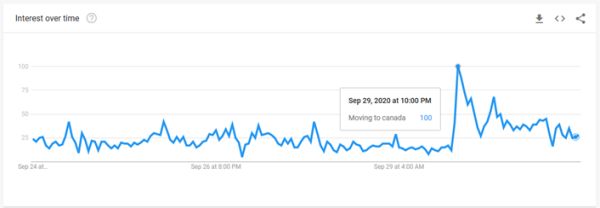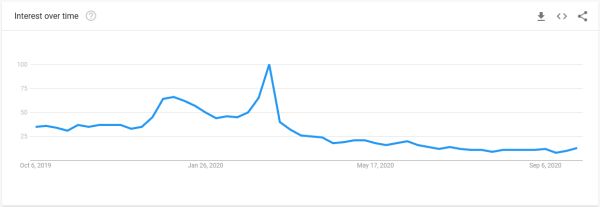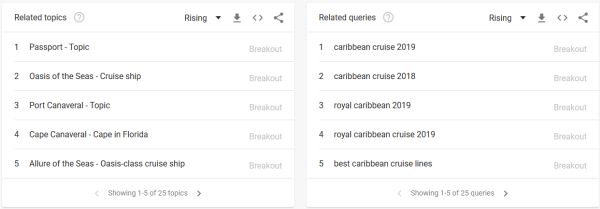Are you using Google Trends to gain your competitive edge? Learn 12 tips for how you can use Google Trends for better SEO.
What is one of the most underutilized and powerful tools for SEO?
Google Trends.
Google Trends an invaluable tool for any serious marketer.
Because of its power, it’s important that you understand how to use it properly and not to “discover trends” where none exists.
In this article, you’ll learn everything you need to know about Google Trends, plus 12 ways to use it for SEO.
What Is Google Trends?
Google Trends is a free tool that provides data and graphs on the popularity of specific search terms used on Google and YouTube.
It was originally introduced in 2006 and the latest version was released in May 2018.
You can use Google Trends to:
- Find out what’s recently trending.
- Identify trending topics or subtopics within an industry or overarching theme.
- Discover geographic search trends local to your area.
For example, the first U.S. Presidential debate between Joe Biden and Donald Trump started at 9 p.m. ET on September 29, 2020.
“Coincidentally,” the United States, the seven-day Google trend for “moving to Canada” peaked at 10 p.m. the same day:
Ready to dive into Google Trends?
Here are 12 tips on how to use Google Trends for better SEO.
1. Keyword Research
You can conduct free keyword research on Google Trends by entering a specific search term in the search box on the homepage.
By default, this runs a search of Google’s most popular keywords – but you can also change it to scour YouTube search data instead.
Google Trends will return a graph of the search term’s popularity over the past year. You can also change the timeframe by expanding the date range.
Looking at the past two or three years of data, versus only the past year, can help you distinguish between fads and true trends.
The keyword research feature helps to identify keywords that are growing in popularity and to avoid keywords that are becoming less popular over time.
2. Finding Related Keywords
What makes Google Trends unique is its ability to recommend related keywords that are currently growing in popularity.
This feature is powerful in that it allows you to identify better, more relevant keywords based on your core search term.
When you type a search term into the homepage, the site returns a list of keywords it considers as closely related to your search.
Google Trends shows you these keywords in order of popularity, and will even provide you with the exact % search volume increase for each one.
Sometimes, it will replace the % search volume with the word “Breakout.”
This means the keyword has increased by over 5,000%.
In my experience, these trends are some of the most important ones to hop on, because they haven’t become competitive yet – meaning you can land the #1 slot on Google’s search page before the keyword becomes mainstream.
The only downside to building your strategy around “Breakout” keywords is they can sometimes turn out to be fads, not real trends.
Unlike evergreen content, the content you build around these trending search terms may eventually go stale.
3. Discover Related Topics
In addition to using Google Trends to discover related search terms, you can also use it to uncover related topics for future content.
In the table to the left of Related Queries, there’s another table called Related Topics.
Instead of showing you specific search terms, this table provides you with insight into broader topics that people are searching for.
You’ll still need to hone in on specific keywords for every topic you choose to write about – but these recommendations can help you find new and trending ideas for future content.
There are a myriad of ways to use Google Trends to your best advantage – but as a content marketer, these are some of the most important ones you should be aware of.
Now, let’s get into some more specific tips for using Google Trends to improve your SEO strategy.
4. Start Big & Whittle Down
A great way to start big?
Enter a big-time keyword for your topic and press Enter.
From there, Google Trends invites you to drill down in the following ways:
- Using Worldwide helps you target a specific market geographically. For example, you’ll see the word “umbrella” peak at different times across different hemispheres.
- Time selection ranges from “2004 – present,” all the way down to the “past 4 hours.”
- Pro tip: Use multiple time selections to get an idea of the long-term trends vs. the short-term trends. More on that later.
- Filtering by category is essential. At least if you’re running a search on “Celtic Thunder” and don’t want to read about Irish weather patterns.
- Web Search Type (including web, image, news, Google Shopping, and YouTube) is another vital category, but more on that in item #3.
With an estimated 6.3 billion searches per day and approximately 2.3 trillion global searches per year, the key takeaway here is to start big, and then filter to get the most relevant information.
5. Context, Context, Context
Google Trends works in a highly relativistic fashion.
The results of today aren’t compared to the overall popularity of all trends, but rather the previous heights of the keywords you entered.
Take the phrase “Caribbean cruise” – pre-COVID-19, a very popular search term.
Here’s what you’ll see in the default settings, which include “Past 12 months.”
It probably comes as no surprise, the popularity of Caribbean cruises has tanked.
But what if we change the date to “2004-present”?
The overall trend looks much more stable. This familiar “heartbeat” pattern is characteristic of seasonal search terms like the Caribbean cruise.
The takeaway: never ignore context.
Try to get rid of your own blind spots before you believe you’ve discovered an insight that no one else has.
Other ways of adding context include:
- Using the + Compare tool to add new keywords.
- Filter by country or category.
- Web searches.
6. Get More Advanced with Specific Search Options
Using “related queries” and other specific search options can help you find new keyword ideas – and even steal business from your competitors.
Here’s how.
You’ll notice five options – many of which even frequent Google Trend users don’t always use:
- Web search (Default).
- Image Search.
- News Search.
- Google Shopping.
- YouTube Search.
Each individual click will yield results based on different segments of your potential markets.
You’ll also notice even more options here for sorting popular topics and queries:
Note this is set to certain defaults: it’s showing you the rising trends.
Click Rising and you’ll also have the option to view the top overall keywords.
Usually, Rising is a better option if you want to identify the hot trends.
These suggestions are highly useful for SEO because they can help inspire new content that embraces new trends.
Don’t be afraid to dig down into the queries, either – there’s a good chance that you can hop on a new trend before it becomes a “breakout” and secure a top position for your latest post.
7. Target by Location
The most cursory use of Google Trends will focus exclusively on keywords.
For the best results, you’ll also need to incorporate location into the mix.
Using local keyword trends, you can see exactly which regions and subregions need your products or services, allowing you to get laser-targeted with your SEO strategy.
Location filtering allows you to hone in on the geographic areas with the highest demand for your products or services.
Using our “Caribbean cruise” trends from earlier, you’ll find that Floridians – or at least, people already in Florida – are the most interested:
Take it a step further with a click on Florida, and you’ll find that the Orlando-Daytona Beach-Melbourne metro region is highest, followed by Miami and then Naples.
8. Trend Predictions
It’s the easiest thing in the world to log on to Google Trends and identify those trends that already leave a trail of breadcrumbs.
The problem?
Every other marketer is using the same data.
If you want additional insights, try using the available data to predict trends.
In order to hop on the latest trends before no one else does, you need to keep a finger on the pulse of seasonal and local trends at all times.
With the help of Google Trends, you can find relevant topics that are trending right now…. and create content about them before no one else does.
Not long ago, the practice of “newsjacking” was a sure way to capitalize on current hot stories. Google Trends can indeed show you exactly which news trends of the day are the hottest.
There are a few ways to do this:
- Identify trends with filtering by specific categories or countries. Today’s top health story might not make major headlines in Google Trends, but it can help you identify topics to watch.
- Compare two key phrases in a single trend. For example, Both “Vote for Trump” (Red) and “Vote for Biden” (Blue) have experienced an upward trend over the past 30 days. What does that mean? That’s s great question to get the conversation started (i.e., boost engagement)
9. Use Long-Tail Key Phrases to Inspire Content
Ranking at the top of the SERPs for “Caribbean Cruise” is still quite an undertaking, but there’s no reason you can’t get to the top of Google search results for a long-tail variation of a trophy phrase.
Switching gears, let’s say you’re writing a music blog and you want to leverage an upcoming event; the Grammy awards.
A click on the trend will yield top questions asked Google, most searched best new artists, and even questions related to the host of the Grammys — such as “how old is James Corden”?
But you want to go deeper and find content that’s truly insightful.
Try using tip #3 to find the associated queries making Google Trends — but don’t stop there.
Cross-reference those queries with each other (ala tip #2) to get a proper context and find out what’s at the core of customer curiosity.
10. Use Data for Video Optimization
Viewing related topics – not just related queries – can help you better optimize your video content for search.
Let’s say you posted a video on how to get discounts on Caribbean cruises.
- Enter in your search term.
- Switch from Web Search to YouTube Search.
- Check out Related Queries and Related Topics.
- Sort by Top or Rising — if you prefer.
From here, you’ll find that people search cruises based on ship classes, not just by searching the ships themselves.
Armed with this knowledge, you are in a better position to write relevant titles and descriptions.
This improves your opportunity to capture YouTube traffic, as cruise season rolls around.
You may even decide to create a series of videos (or blog content) explaining the different ship classes available on your cruise line.
11. Use Cyclical Trends for Brand Positioning
Let’s say you’re optimizing for a wedding boutique.
Has interest in weddings been impacted by COVID-19?
A simple search for “wedding” over the past 5 years reveals that interest in weddings slipped in mid-2020, but has rebounded.
Historically, the interest in weddings is pretty even, year-round.
From this, you can glean that wedding plans are back on track, regardless of the pandemic, and historically don’t compete with holidays.
That doesn’t mean that weddings, themselves, are the same as a year ago. That will require some additional research.
12. Identify Blind Spots & Don’t Misread the Trends
Advanced use of Google Trends means you’ll go a step beyond whatever you think your current insight is to see if you have blind spots.
For example:
- Don’t ever trust a single snapshot. Always get a broader view of a timeline to see what else is happening.
- Is an increased trend in one key phrase still dwarfed by more important ones? Always look for context.
- Researching weddings for #8, I encountered a drastic increase in YouTube trends for weddings during the summer of 2017 – far greater than in previous summers – which almost quadrupled previous interest. Further research couldn’t identify a specific keyword, except to show a drastic increase in wedding interest in South Asia. This geographically-driven trend is a great example of a unique insight that comes from the never-ending search for understanding context.
Knowing what you now do, you can use Google Trends to plan your content calendar.
Because you’re aware of your blind spots (while your competition may not be), you can delve deeper into the search results for more sophisticated data to inform your SEO strategy.
Summary
Google Trends data is more important and valuable than ever.
There are unique insights to be gleaned for those willing to go beyond a basic search.
The key is sticking with your queries until you find the insights – even if they aren’t always obvious.






